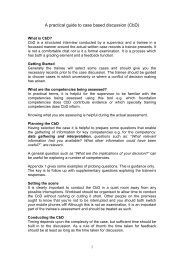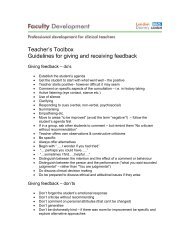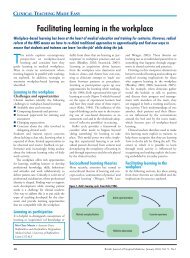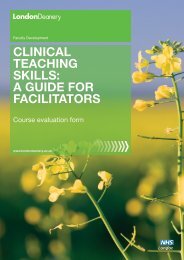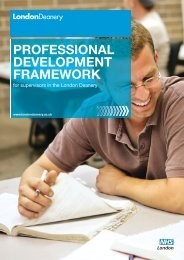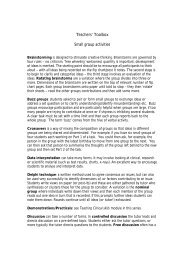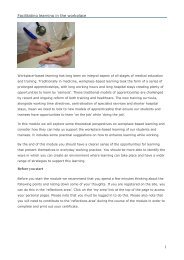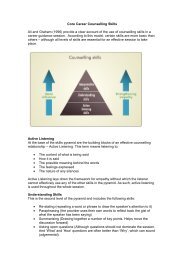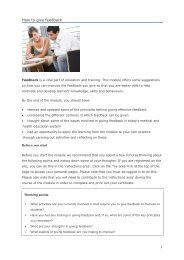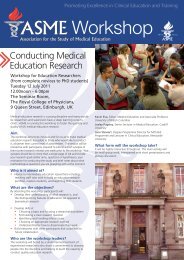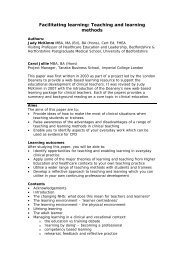A GuIdE for fACILITATorS - Faculty Development - London Deanery
A GuIdE for fACILITATorS - Faculty Development - London Deanery
A GuIdE for fACILITATorS - Faculty Development - London Deanery
You also want an ePaper? Increase the reach of your titles
YUMPU automatically turns print PDFs into web optimized ePapers that Google loves.
Clinical Teaching Skills:<br />
A GUIDE FOR FACILITATORS<br />
notes <strong>for</strong> Facilitators<br />
Session 2:<br />
09.45–10.30 Teaching and Learning in<br />
Clinical Practice<br />
The purpose of this session is to include all participants in the<br />
process of reflecting on teaching and learning and what it means<br />
to them. Several theoretical frameworks are introduced to enable<br />
reflection on teaching practice, and <strong>for</strong> participants to look at<br />
their own learning experiences in order to review the roles and<br />
responsibilities of both teachers and leaners.<br />
The session looks at the overview of teaching and learning. It is<br />
important that facilitators remember that most course participants<br />
will have been teaching in some way <strong>for</strong> some time, but will usually<br />
feel that they have had little <strong>for</strong>mal preparation <strong>for</strong> this. While<br />
this session will introduce some new theoretical knowledge, it is<br />
usually more positively received if that new in<strong>for</strong>mation arises out<br />
of the views and experiences of the group. So, where possible,<br />
use activities to encourage the participants to reflect on their<br />
experiences as learners and teachers. You can invite the group<br />
to participate and comment all through this session. This is an<br />
opportunity <strong>for</strong> participants to share their experiences with<br />
one another.<br />
Introduce this session by explaining that, as educators, sometimes<br />
we may fall into the trap of thinking that just because we have<br />
taught something, it has been learned. We often describe teaching<br />
and learning in terms of ‘delivery’, which makes it commoditybased.<br />
Knowledge and skills may be, to a degree, commodities<br />
that can be transferred from one person to another, but much<br />
of postgraduate medical education is about process rather than<br />
product. In terms of clinical skills, judgements, decision making<br />
and professional behaviours, such attributes cannot be ‘delivered’<br />
to trainees; they must be developed through a social, collaborative<br />
process of working together.<br />
Slide 4: Clinical teaching skills.<br />
Dreyfus and Dreyfus (1986) developed a model <strong>for</strong> understanding<br />
skills development. Slide 4 can be used to discuss how trainees<br />
learn as they progress from novice to expert. This diagram can be<br />
drawn up on a flipchart and talked through if you prefer. It lends<br />
itself well to the analogy of learning to drive.<br />
Bottom left quadrant: feeling excited about the start of driving<br />
lessons; not knowing that it isn’t as easy as it looks. It may be<br />
useful to draw a smiley face in this box to show the ‘ignorance is<br />
bliss’, nature of this stage of learning.<br />
Top left quadrant: realising after a mile or so behind the wheel<br />
that driving a car is not as easy as it looks – that one is not able to<br />
do it as well as one initially thought. It may be useful to draw a sad<br />
face here as the learner realises what a task is ahead of them and<br />
feels de motivated and incompetent.<br />
Top right quadrant: beginning to be competent and ultimately<br />
passing the driving test. But being aware that the level of<br />
competence needed to pass the test is not the same as that of an<br />
experienced driver. Still being nervous when driving alone. It may<br />
be useful to draw a dubious face – with a flat line mouth to show a<br />
learner who has the basic skills but is still not a confident driver.<br />
Bottom right quadrant: being an experienced driver who does<br />
not need to be consciously aware of every action while driving a<br />
car. Being able to have the radio on and hold a conversation. Not<br />
always remembering once you reach your destination which route<br />
you took to get there. You could draw a smiley face here.<br />
<strong>London</strong> <strong>Deanery</strong> Clinical Teaching Skills<br />
6



